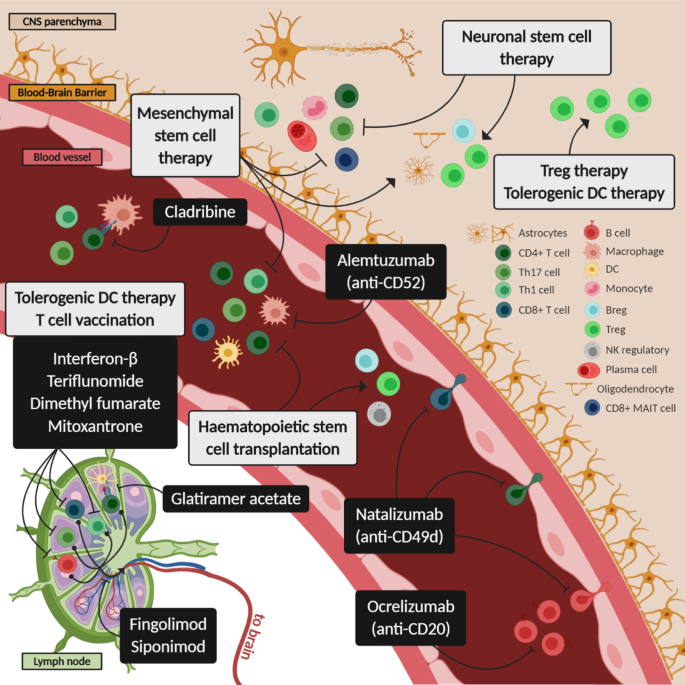Unknown Facts About Regenerative Medicine For Multiple Sclerosis
What Does Regenerative Medicine For Multiple Sclerosis Mean?
Table of ContentsGetting The Regenerative Medicine For Multiple Sclerosis To WorkAll About Regenerative Medicine For Multiple SclerosisThe 9-Minute Rule for Regenerative Medicine For Multiple SclerosisThe Facts About Regenerative Medicine For Multiple Sclerosis Uncovered5 Easy Facts About Regenerative Medicine For Multiple Sclerosis DescribedThe Only Guide for Regenerative Medicine For Multiple SclerosisThe Basic Principles Of Regenerative Medicine For Multiple Sclerosis
The mesenchymal stem cells hair transplanted throughout stem cell treatment can divide and grow to develop brand-new cells that can fill in the damaged cells of the anxious tissue. This could restore neurological features in clients with this problem. These benefits of stem cell therapy are further sustained by the capability of MSCs to promote healing.People with several sclerosis are typically treated with mesenchymal stem cells. These are multipotent stem cells that have the ability to separate and grow to form a vast array of cell enters the body. Once transplanted, these stem cells can develop to develop healthy afferent neuron therefore supporting the regrowth of the broken tissues of the anxious system.
Once hair transplanted, the stem cells move to locations of inflammation or damage within the main nerves (CNS). They are naturally attracted to the sites of injury where the body immune system is attacking the myelin sheath, the protective treatment of nerve fibers. The stem cells work by advertising the repair work and regrowth of damaged myelin, possibly recovering function to impacted afferent neuron.
The smart Trick of Regenerative Medicine For Multiple Sclerosis That Nobody is Talking About
Stem Cell Research Study on MS The National Multiple Sclerosis Culture, along with other companies, is actively moneying and supporting study into mesenchymal stem cell therapy for several sclerosis to explore their possible and enhance treatment methods. The objective is to establish safer and extra reliable methods to utilize stem cells in treating MS.
The 25-Second Trick For Regenerative Medicine For Multiple Sclerosis
Here are below from testimonials of clients Swiss Medica clinic. The patient took a trip from Romania seeking treatment for MS after listening to favorable comments regarding stem cell therapy for the condition.
Get a free online appointment to find out just how stem cells will work for your case, and what are the duration and expense of the treatment. Uccelli, A., Laroni, A., Brundin, L., Clanet, M., Fernandez, O., Nabavi, S. M. Regenerative Medicine for Multiple Sclerosis., Muraro, P. A., Oliveri, R. S., Radue, E. W., Sellner, J., Soelberg Sorensen, P., Sormani, M. P., Wuerfel, J. T., Battaglia, M
Stem cells are cells in the body that can mature into develop right into that serve a specific functionParticular There are 2 primary types of stem cells: beginning stem cells and adult stem cells.
are found in some adult cells and organs consisting of the bone marrow, skin, blood, and brain. Adult stem cells are not as flexible as embryonic stem cells and are for that reason more minimal in regards to the sorts of cells they grow right into. The unique homes of stem cells give guarantee for new treatments that can slow/halt MS disease activity and repair service cells damage in the main nerves.
Little Known Questions About Regenerative Medicine For Multiple Sclerosis.

The treatment includes accumulating stem cells from an individual's very own (autologous) bone marrow. The person is after that treated with radiation treatment to diminish the immune system and stem cells are reintroduced into the body where they develop into new, healthy and balanced immune cells - Regenerative Medicine for Multiple Sclerosis. Stem cells can be infused right into the body in various methods

In 2000, click over here now the MS Culture of Canada and MS Scientific Research Foundation funded a clinical test including HSC transplants, led by Drs. Mark Freedman and Harry Atkins from the Ottawa Health Center Research Institute/University of Ottawa. The aHSC therapy readily available in Canada is a therapy that makes use of high-dose chemotherapy, likewise called conditioning.

Regenerative Medicine For Multiple Sclerosis - An Overview
Neural stem cells (NSC) are located in the mind and can grow into numerous types of recommended you read brain cells including nerve cells, oligodendrocytes, and astrocytes. NSCs might serve to fix or protect the this contact form brain and modulate the body immune system. Early scientific tests in non-human primates showed that therapy with NSCs profited the progression of MS-like illness in animal versions.
The outcomes from these safety and security research studies are positive for future stem cell and regenerative medicine therapies in MS. Future medical tests (phase 2 and 3) with larger varieties of participants and controls are essential to evaluate the efficacy of this therapy for MS. As demonstrated by the examples above, there is a huge range of study occurring that will certainly offer added responses about the use of stem cells to deal with MS.
Stem cell therapy is thought about secure, however, like any clinical procedure, it brings some risks, such as momentary swelling or discomfort at the shot site. However, severe adverse effects are uncommon when executed by certified experts.
Get This Report on Regenerative Medicine For Multiple Sclerosis
Multiple sclerosis (MS) is a chronic illness of the central nerves that influences the brain and spine. It is identified by the destruction of myelin, a compound that covers nerve fibers, causing disturbances in interaction in between the brain and the rest of the body. Symptoms can vary commonly and consist of muscle weakness, vision issues, imbalance, and tiredness.
Numerous sclerosis is identified by the body immune system wrongly assaulting the protective sheath (myelin) that covers nerve fibers, creating interaction issues in between the brain and the remainder of the body. The condition can cause the wear and tear or long-term damages of nerves. Symptoms differ extensively amongst individuals and can consist of fatigue, wheelchair problems, pain, and cognitive modifications.